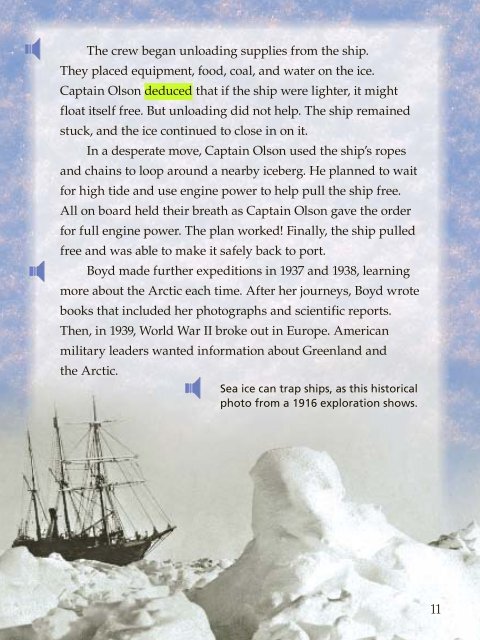Lesson 13:Louise Arner Boyd and Glaciers
Lesson 13:Louise Arner Boyd and Glaciers
Lesson 13:Louise Arner Boyd and Glaciers
Create successful ePaper yourself
Turn your PDF publications into a flip-book with our unique Google optimized e-Paper software.
The crew began unloading supplies from the ship.<br />
They placed equipment, food, coal, <strong>and</strong> water on the ice.<br />
Captain Olson deduced that if the ship were lighter, it might<br />
float itself free. But unloading did not help. The ship remained<br />
stuck, <strong>and</strong> the ice continued to close in on it.<br />
In a desperate move, Captain Olson used the ship’s ropes<br />
<strong>and</strong> chains to loop around a nearby iceberg. He planned to wait<br />
for high tide <strong>and</strong> use engine power to help pull the ship free.<br />
All on board held their breath as Captain Olson gave the order<br />
for full engine power. The plan worked! Finally, the ship pulled<br />
free <strong>and</strong> was able to make it safely back to port.<br />
<strong>Boyd</strong> made further expeditions in 1937 <strong>and</strong> 1938, learning<br />
more about the Arctic each time. After her journeys, <strong>Boyd</strong> wrote<br />
books that included her photographs <strong>and</strong> scientific reports.<br />
Then, in 1939, World War II broke out in Europe. American<br />
military leaders wanted information about Greenl<strong>and</strong> <strong>and</strong><br />
the Arctic.<br />
Sea ice can trap ships, as this historical<br />
photo from a 1916 exploration shows.<br />
11

















